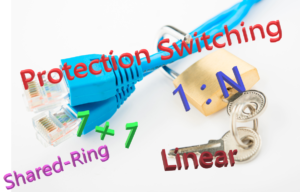What is the Normal Traffic Signal for APS (Automatic Protection Switching) Purposes?
ITU-T G.808 Defines the Normal Traffic Signal as:
A traffic signal that is protected by two alternative transport entities called working and protection transport entities.
What does all that mean?
In many applications, some traffic signals are critical to the Networking Service provider (and their financial bottom-line) and the end customers themselves.
Hence, these signals warrant a certain amount of protection in the form of some system redundancy.
In the APS (Automatic Protection Switching) World, we call this critical traffic signal the Normal Traffic Signal.
I recognize the apparent silliness in calling a critical traffic signal worthy of system-level protection a mundane name, such as the Normal Traffic Signal.
But that is the language used by the Standards Committee and the Industry (as a whole).
So who are we to buck the trend?
A Normal Traffic Signal becomes protected (in a system design) whenever the signal path between two Network Elements (that reside at the opposite ends of this particular protection group) provides both a Working and Protection Transport Entity (path) for that Normal Traffic Signal.
Figure 1 illustrates two Network Elements that form a protection group and are connected.
In this figure, we have connected these two Network Elements through two separate paths.
We will call one of these paths the Working Transport Entity and the other path the Protect Transport Entity.

Figure 1, Illustration of Two Adjacent Network Elements connected via a Protection Group (e.g., the Working and Protection Transport Entity).
So How Does All of This Work?
In most network system designs, the Network Elements will (by default) transmit the Normal Traffic Signal over the Working Transport Entity.
This Normal Traffic signal can be of any type (e.g., SONET/SDH, OTN, Ethernet, etc.).
Now, let’s suppose that some impairment were to occur within the traffic signal (that is, traveling from Network Element West to Network Element East).
The Network Element East will likely respond to this event by detecting and declaring a service-affecting or signal degrade defect with this traffic signal (e.g., SD, SF, etc.).
The overall system (consisting of both Network Element West and Network Element East) will respond to this event by redirecting the Normal Traffic Signal through the Protect Transport Entity instead of the (now defective) Working Transport Entity, as we show in Figure 2.
In other words, if the Working Transport entity (path) fails, then we can (and will) use the Protect Transport entity (path) as a Backup.

Figure 2, Illustration of Network Element East declaring a defect (with the traffic it receives from Network Element West) and (in response) invoking Protection Switching.
NOTE: Figure 2 shows the two Network Elements invoking Bidirectional Protection Switching in response to Network Element East declaring a service-affecting defect condition.
The Network Elements could have also responded to this defect condition by using Unidirectional Protection Switching instead.
Please see Unidirectional and Bidirectional Protection Switching posts to learn more about these protection switching schemes/options.
In Summary
A Normal Traffic Signal is a protected signal. It is an important signal that we will bear some expense to ensure that it gets from Point A to Point B, even with service-affecting or signal degrade defect conditions in the network.
This means that as a given Network Element (at one end of a protection group) transmits the Normal Traffic signal to the other Network Element (at the other end of the protection group), it can do so by sending this Normal Traffic signal over one of two possible signal paths:
- The Working Transport entity, and
- The Protect Transport entity.
The Network Element will (by default) transmit the Normal Traffic signal over the Working Transport entity.
However, suppose the Network detects and declares a service-affecting or signal degrade defect within this Working Transport entity. In that case, the Network System will redirect the Normal Traffic Signal through the Protection Transport entity (e.g., the backup signal path) instead.
Has Inflation got You Down? Our Price Discounts Can Help You Beat Inflation and Become an Expert on OTN!! Click on the Banner Below to Learn More!!
Discounts Available for a Short Time!!
Click on the Image Below to see more Protection-Switching related content on this Blog:



